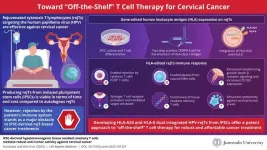(Press-News.org) An inexpensive, cavity-fighting liquid called silver diamine fluoride (SDF) works as well as dental sealants to keep tooth decay at bay in a school cavity prevention and treatment program, according to a new study by researchers at NYU College of Dentistry.
The study, which followed more than 4,000 elementary school students for four years and is published in JAMA Pediatrics, shows that SDF is an effective alternative to sealants, and can increase access to dental care while reducing costs.
Dental cavities are the most prevalent chronic disease in children and can lead to pain, school absences, and lower academic performance. To prevent cavities, especially among children less likely to see a dentist, the Centers for Disease Control and Prevention (CDC) supports the use of school sealant programs. In sealant programs, dental professionals visit schools to apply a thin, protective coating to the surface of teeth that hardens and safeguards against decay.
SDF has emerged as another promising treatment for fighting cavities. Originally approved by the FDA for treating tooth sensitivity, the solution is brushed onto the surface of teeth, killing decay-causing bacteria and remineralizing teeth to prevent further decay.
“A growing body of research shows that SDF—which is quicker to apply and less expensive than sealants—can prevent and arrest cavities, reducing the need for drilling and filling,” said Richard Niederman, DMD, professor of epidemiology & health promotion at NYU College of Dentistry and the study’s senior author.
SDF in schools
Researchers at NYU College of Dentistry led CariedAway, the nation’s largest school-based cavity prevention study, to compare the use of SDF and traditional sealants. The study included approximately 4,100 children in New York City elementary schools; more than a quarter of kids had untreated cavities at the start of the study.
At each school visit, a team of health professionals examined children’s teeth and applied either sealants or SDF followed by fluoride varnish, depending on which treatment the school was randomly assigned to receive. Sealants were administered by dental hygienists, while SDF was applied by either dental hygienists or registered nurses, all under the supervision of a dentist. Starting in 2018, the team visited each school twice a year, although the COVID-19 pandemic and school closures led to missed visits.
The researchers reported last year in the journal JAMA Network Open that a single treatment of either SDF or sealants prevented 80% of cavities and kept 50% of existing cavities from worsening two years later. The team continued their study for another two years, and in their study published in JAMA Pediatrics, found that SDF and sealants prevented roughly the same number of cavities after children were followed for a total of four years. Moreover, both sealants and SDF reduced the risk of decay at each follow-up visit.
“Our longitudinal study reaffirms that both sealants and SDF are effective against cavities. SDF is a promising alternative that can support school-based cavity prevention—not to replace the dental sealant model, but as another option that also prevents and arrests decay,” said Ryan Richard Ruff, PhD, MPH, associate professor of epidemiology & health promotion at NYU College of Dentistry and the study’s first author.
“Most research shows that SDF can stop a cavity from progressing further. Our study demonstrated that SDF can prevent cavities from happening in the first place,” said Tamarinda Barry Godín, DDS, MPH, associate program director and supervising dentist for CariedAway, research scientist at NYU College of Dentistry, and the study’s coauthor.
An “untapped” oral health workforce
Embracing SDF for cavity prevention and treatment in schools could keep kids from needing fillings, saving families and the healthcare system money. Yet these programs can only succeed if there are enough health professionals to provide care.
The NYU researchers found that children who had SDF applied by dental hygienists and registered nurses had similar outcomes, suggesting that nurses—including school nurses—could play a crucial role in cavity prevention programs.
“Nurses may be an untapped resource for addressing oral health inequities,” added Ruff. “Our results suggest that nurses can effectively provide this preventive care, which could dramatically improve access, given the role of school nurses and the size of the nursing workforce.”
This research was funded by the Patient-Centered Outcomes Research Institute (PCS-160936724). The CariedAway cavity prevention model is currently being used in three New Hampshire school districts, supported by Northeast Delta Dental.
About NYU College of Dentistry
Founded in 1865, New York University College of Dentistry (NYU Dentistry) is the third oldest and the largest dental school in the US, educating nearly 10 percent of the nation’s dentists. NYU Dentistry has a significant global reach with a highly diverse student body. Visit dental.nyu.edu for more.
END
Low-cost liquid tames tooth decay
Silver diamine fluoride prevents cavities and keeps existing ones from worsening in school-based program
2024-03-04
ELSE PRESS RELEASES FROM THIS DATE:
More than 1/3 illicit drugs sold on the dark web contain unexpected substances
2024-03-04
Testing of illicit drugs bought online found 35% were not what they said they were, highlighting the urgent need for more local drug testing facilities in Australia to prevent harm and overdose.
The RMIT-led study analysed 103 illicit drug samples sourced from the now-defunct dark web forum Test4Pay in collaboration with the Australian National University, UNSW Sydney and Canadian testing facility Get Your Drugs Tested.
While 65% of samples contained only the advertised substance, the study found 14% of samples had a mixture ...
A better way to deliver fetal therapy for serious genetic disorders
2024-03-04
In a discovery that opens the door to a less invasive way of treating some serious disorders before birth, UC San Francisco scientists have found that delivering medicine through amniotic fluid is as effective as delivering it to the fetal brain via cerebrospinal fluid. The experiment was done in mice with a genetic disorder called Angelman syndrome.
Treating genetic diseases like Angelman in utero could prevent serious symptoms that begin while the fetus is still developing. It’s also easier to access neurons in the fetal brain because the blood-brain barrier that normally acts as a filter ...
Researchers develop amphibian-inspired camouflage skin
2024-03-04
Inspired by amphibians such as the wood frog, investigators designed and synthesized a new type of camouflage skin involving one-dimensional photonic crystal structures assembled in three-dimensional flexible gels.
As described in Advanced Optical Materials, the camouflage skin can quickly recognize and match the background by modulating the optical signals of external stimuli. It demonstrated excellent mechanical performance, self-adaptive camouflage capabilities in response to complex surroundings, and long-term stability in real-world living environments. Bright structural color and mechanical flexibility were maintained even at temperatures as low as -80℃.
The advance ...
Network of quantum sensors boosts precision
2024-03-04
The quantum systems employed in quantum technologies, for example single atoms, are also very sensitive: any interaction with the environment can induce changes in the quantum system, leading to errors. However, this remarkable sensitivity of quantum systems to environmental factors actually represents a unique advantage. This sensitivity enables quantum sensors to surpass conventional sensors in precision, for example when measuring magnetic or gravitational fields.
Noise cancellation using correlation spectroscopy
The delicate quantum properties needed for sensing can be covered up ...
Robotic hip exoskeleton shows promise for helping stroke patients regain their stride
2024-03-04
Robotic Hip Exoskeleton Shows Promise for Helping Stroke Patients Regain Their Stride
A portable robotic device created by UMass Amherst researchers provides new avenue for making state-of-the-art gait rehabilitation methods more effective and accessible
AMHERST, Mass. – More than 80% of stroke survivors experience walking difficulty, significantly impacting their daily lives, independence, and overall quality of life. Now, new research from the University of Massachusetts Amherst pushes forward the bounds of stroke recovery ...
Conservation value of field research stations grossly misunderstood and underfunded according to 173 conservation scientists in new study
2024-03-04
SAN DIEGO – Funding of field conservation research stations worldwide has been drastically reduced since the beginning of the COVID-19 pandemic, raising the alarm of more than 170 conservation researchers representing 157 field stations in 56 countries in a new paper published in Conservation Letters. The authors contend that field research stations have a high return on investment and are essential and highly effective tools for biodiversity conservation.
Trillions of U.S. dollars were mobilized in economic recovery following the pandemic, yet the authors raise concerns ...
Study underscores social factors of low breast cancer screening in the US
2024-03-04
There is a pressing need to explore and understand which social determinants of health (SDOH) and health inequities act as significant influential factors that contribute to low breast cancer screening behaviors in the United States.
Health disparities have been consistently associated with delayed screening, which then contributes to higher mortality rates among both Hispanic and Black populations. Moreover, poverty, lack of education, neighborhood disadvantage, residential segregation, racial discrimination, lack of social support and social isolation ...
Nanomedicine research aims to transform treatment of aortic aneurysms
2024-03-04
Aortic aneurysms are bulges in the aorta, the largest blood vessel that carries oxygen-rich blood from the heart to the rest of the body. Smoking, high blood pressure, diabetes, or injury can all increase the risk of aneurysms, which tend to occur more often in Caucasian male smokers over the age of 65.
“The soft tissues that make up blood vessels act essentially like rubber bands, and it’s the elastic fibers within these tissues that allow them to stretch and snap back,” says Professor Anand Ramamurthi, chair of the Department of Bioengineering in Lehigh University’s P.C. Rossin College of Engineering ...
HIV medication can be used safely with gender-affirming hormone therapy
2024-03-04
New research definitively shows that HIV antiretrovirals can be taken together with gender-affirming hormone therapy without changing how well either drug works. The study findings can help healthcare providers address potential patient concerns that one drug will counteract the other.
“This study is the first head-to-head pharmacokinetic analysis of two common HIV medications and long-term feminizing hormone therapy use,” says Walter Kraft, MD, director of the Division of Clinical ...
Gene-edited lymphocytes and the path toward ‘off-the-shelf’ therapy against cervical cancer
2024-03-04
Cervical cancer is among the most common malignancies affecting women worldwide. In 2020 alone, approximately 600,000 women were diagnosed with this disease, and over 314,000 died from it. In 99% of the cases, cervical cancer cells harbor human papilloma virus (HPV), and thus, HPV vaccines are an effective way to mitigate the risk of developing this disease. Unfortunately, such preventive measures are useless against established cancers, which are generally incurable once they become metastatic or relapsing.
Fortunately, scientists have made substantial progress in developing a promising ...
LAST 30 PRESS RELEASES:
Boosting the cell’s own cleanup
Movement matters: Light activity led to better survival in diabetes, heart, kidney disease
Method developed to identify best treatment combinations for glioblastoma based on unique cellular targets
Self-guided behavioral app helps children with epilepsy sleep earlier
Higher consumption of food preservatives is associated with an increased risk of type 2 diabetes
NTU Singapore-led team captures first-ever ‘twitch’ of the eye’s night-vision cells as they detect light, paving the way for earlier detection of blindness-causing diseases
Global aviation emissions could be halved through maximising efficiency gains, new study shows
Fewer layovers, better-connected airports, more firm growth
Exposure to natural light improves metabolic health
As we age, immune cells protect the spinal cord
New expert guidance urges caution before surgery for patients with treatment-resistant constipation
Solar hydrogen can now be produced efficiently without the scarce metal platinum
Sleeping in on weekends may help boost teens’ mental health
Study: Teens use cellphones for an hour a day at school
After more than two years of war, Palestinian children are hungry, denied education and “like the living dead”
The untold story of life with Prader-Willi syndrome - according to the siblings who live it
How the parasite that ‘gave up sex’ found more hosts – and why its victory won’t last
When is it time to jump? The boiling frog problem of AI use in physics education
Twitter data reveals partisan divide in understanding why pollen season's getting worse
AI is quick but risky for updating old software
Revolutionizing biosecurity: new multi-omics framework to transform invasive species management
From ancient herb to modern medicine: new review unveils the multi-targeted healing potential of Borago officinalis
Building a global scientific community: Biological Diversity Journal announces dual recruitment of Editorial Board and Youth Editorial Board members
Microbes that break down antibiotics help protect ecosystems under drug pollution
Smart biochar that remembers pollutants offers a new way to clean water and recycle biomass
Rice genes matter more than domestication in shaping plant microbiomes
Ticking time bomb: Some farmers report as many as 70 tick encounters over a 6-month period
Turning garden and crop waste into plastics
Scientists discover ‘platypus galaxies’ in the early universe
Seeing thyroid cancer in a new light: when AI meets label-free imaging in the operating room
[Press-News.org] Low-cost liquid tames tooth decaySilver diamine fluoride prevents cavities and keeps existing ones from worsening in school-based program





